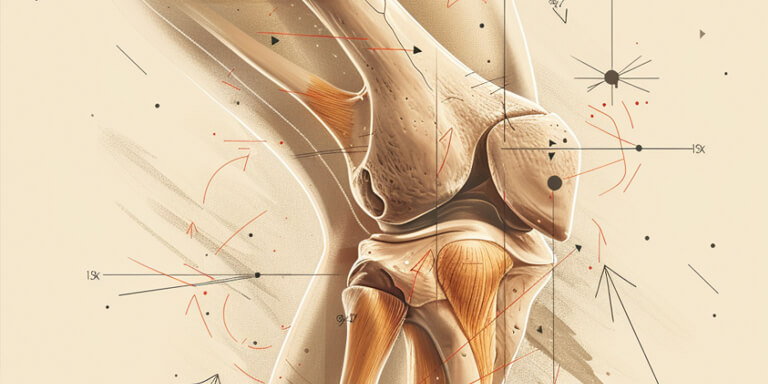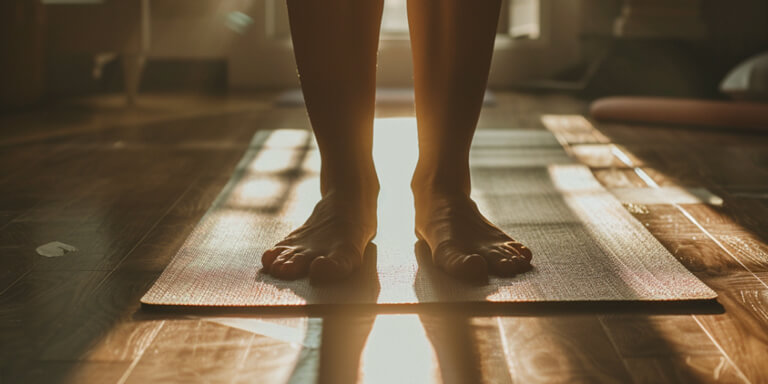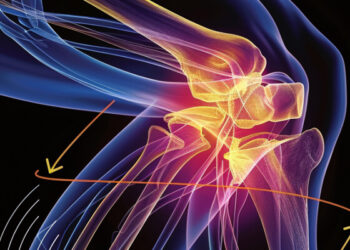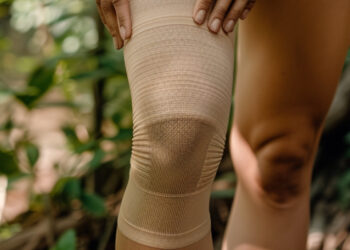Did you know that by the age of 85, more than half the population will experience knee pain onset? While we often associate aching knees with the frailty of advanced years, the genesis of age-related knee discomfort can actually be traced back to our mid-40s. Orthopedic specialists like Nicholas A. DiNubile, MD, and Daniel Valaik, MD, liken the progression to the gradual wear of car tires—highlighting that joint health, much like vehicular upkeep, requires attention long before breakdowns occur.
The complexity of the knee joint makes it susceptible to a range of issues that compound over time. From cartilage thinning to increased incidents of arthritis, aging knees narrate the history of a life in motion. But it’s not just the passage of time that’s culpable; the lifestyle choices and the types of physical activities we engage in can accelerate or mitigate the wear-and-tear that beckons discomfort and hampers mobility.
Key Takeaways
- The onset of knee pain is commonly linked with aging, typically becoming noticeable from the age of 45.
- Regular ‘wear-and-tear’ and conditions such as osteoarthritis are prime contributors to knee discomfort as we age.
- Heredity, past knee injuries, and lifestyle factors also play a significant role in determining knee health.
- Maintaining joint health is crucial and begins with understanding the natural deterioration process of the knee.
- Experts, including those with notable orthopedic expertise, support the analogy of knee cartilage wear to the wearing away of car tires, emphasizing the predictability of knee pain’s onset.
Understanding Knee Pain as We Age
As the years pass, our bodies undergo various changes, and the knees, often considered the workhorses of the human skeletal system, are no exception. With advancing age, age-related knee issues become more common, signalling the onset of knee joint degeneration and associated discomfort. A deeper grasp of these developments is essential to manage and adjust to the symptoms of knee pain effectively.
Causes of Age-Related Knee Pain
The wear and tear of knee cartilage, particularly the menisci, are primarily responsible for the pain people feel as they grow older. The menisci serve as vital shock absorbers in the knee joint, but with time their resilience diminishes. Factors contributing to this decline include repetitive movements from activities such as running, climbing, or even prolonged standing, which can exacerbate the regular wear-and-tear damage associated with aging.
The Impact of Osteoarthritis on Knees
Osteoarthritis is a common adversary in the battle against knee joint degeneration. This degenerative joint disease leads to the gradual erosion of cartilage, culminating in direct bone-on-bone contact that can cause significant discomfort. The resulting symptoms include a range of distressing physical limitations.
Osteoarthritis can force the bones to rub against each other, causing swelling, stiffness, and severe pain that can hinder daily activities and degrade the quality of life.
Recognizing the Symptoms and Progression
Identifying the onset and evolution of knee pain is crucial for timely intervention. Symptoms typically include persistent pain beneath the kneecap, which intensifies during activities requiring knee flexion, such as kneeling, squatting, or navigating stairs. While these symptoms may begin as early as one’s 30s, the condition becomes increasingly common with the advance into the 60s and 70s.
Here is a closer look at the symptoms and how they may progress:
- In the initial stages, mild discomfort may be noted during vigorous activity or after prolonged periods of being sedentary.
- As the condition advances, pain might occur even during moderate activities, accompanied by swelling and a noticeable decrease in joint mobility.
- In severe cases, constant pain may persist even at rest, signaling extensive knee joint degeneration and the need for professional medical evaluation.
Understanding these factors allows for a proactive approach in managing knee health and alleviating pain associated with age-related deterioration. Recognizing and responding to the early symptoms of knee pain can lead to a more active and comfortable lifestyle, even as we age.
Risk Factors Contributing to Knee Discomfort
Understanding knee pain risk factors is crucial in taking proactive measures to prevent discomfort and injury. The path to sustaining healthy knees over time is paved with knowledge about what can potentially heighten the risk of pain and how those risks can be mitigated.

Overweight and knee pain have a well-documented connection. It has been established that for every pound of body weight, a multiplied force impacts the knees during daily activities, especially when walking down stairs or on an incline. This additional pressure can aggravate knee structures leading to accelerated wear and discomfort over time. Below is a breakdown of the primary risk factors:
- Bodyweight: Excess weight significantly increases the stress on knee joints.
- Injuries: Previous knee injuries such as ACL tears and fractures can predispose one to chronic knee issues.
- Arthritis: Conditions like rheumatoid arthritis and gout contribute to joint deterioration adding to knee discomfort.
- Occupational Hazards: Jobs that require long hours of standing or repetitive knee stress can lead to knee pain.
- High-Impact Activities: Sports and exercises that exert substantial force on the knees may accelerate pain onset.
Considering the wide range of contributing factors, managing knee health requires an all-encompassing approach. The table below offers a comparative glimpse into how different risk factors relate to subsequent knee pain:
| Risk Factor | Impact on Knees | Suggested Preventative Measures |
|---|---|---|
| Excess Body Weight | Increases mechanical pressure on knee joints | Weight management through diet and exercise |
| Knee Injuries | Can lead to instability and degenerative changes | Use of protective gear and proper technique during activities |
| Arthritic Conditions | Causes inflammation and cartilage breakdown | Avoidance of inflammatory foods and regular medical checkups |
| Occupational Stress | Repetitive strain and overuse of the knee structure | Periodic rest and proper ergonomic practices |
| High-Impact Activities | Can cause acute damages and accelerate wear-and-tear | Incorporating low-impact exercises into fitness routines |
It is important to recognize these risk factors early on and take steps to protect the knees. Modifying activities where necessary and seeking regular medical advice can go a long way in maintaining knee health. As we consider these factors, it’s not just the presence of one risk that should concern us; rather, it’s the cumulative effect of multiple risks that often leads to significant knee pain and discomfort.
Prevention Strategies: Safeguarding Your Joints
Embarking on a proactive journey towards knee pain prevention can yield lasting benefits for your joint health. Fundamental to this is embracing a lifestyle that supports joint preservation and reduces the risks of developing knee pain.
Opting for an anti-inflammatory diet, such as the nutrient-rich Mediterranean diet, has been shown to provide numerous health benefits, including those relating to joint health.
Furthermore, strengthening the muscles around the knee serves as a critical component of joint health strategies. This not only relieves pressure on the knee joints but also improves shock absorption capabilities, directly correlating with reduced knee pain risks.
- Maintaining proper hydration is crucial for ensuring that the cartilage, which cushions the joints, remains resilient and functional.
- Avoiding harmful habits such as smoking, which is known to cause inflammation, can significantly benefit joint health.
- Weight management plays a pivotal role in reducing the load on the knee joints during daily activities, thereby slowing cartilage wear and improving overall mobility.
Integrating these fundamental strategies into your daily routine can be the keystone in bolstering your knee health and minimizing discomfort. Let’s not forget that losing even a small percentage of body weight can lead to considerable relief for your knees.
| Strategy | Joint Health Benefit | Additional Advantages |
|---|---|---|
| Anti-inflammatory Diet | Reduces joint inflammation | Improves overall well-being |
| Muscle Strengthening | Enhances stability and shock absorption | Promotes balance and physical fitness |
| Hydration | Protects and maintains cartilage | Benefits all bodily functions |
| Avoiding Smoking | Reduces inflammation-related damage | General health improvement |
| Weight Management | Decreases pressure on knees | Enhances mobility and quality of life |
By implementing these strategies, not only will you lay the foundation for a healthier knee condition, but you will also contribute positively to your overall health profile. Always remember that the steps you take today to foster knee health can pay off significantly as you age.
Lifestyle and Home Remedies for Knee Health
Maintaining knee health is essential for mobility and pain-free movement as we age. By integrating simple lifestyle adjustments and home remedies, we can significantly improve knee function and delay or reduce the impact of common joint issues. Whether you’re currently experiencing knee discomfort or are looking to prevent future problems, these strategies can empower you to take charge of your joint health.
Exercise: Strengthening Muscles Around the Knee
Engaging in strengthening knee exercises is crucial for supporting the delicate joint structures. Specific workouts aimed at bolstering the quadriceps, hamstrings, core, and hip muscles will not only stabilize your knees but also distribute the load evenly during physical activity, alleviating undue stress on your knee joints. Here’s a snapshot of effective exercises:
- Squats and lunges to fortify the quadriceps and hamstrings
- Leg presses and leg curls for comprehensive lower body strengthening
- Core workouts such as planks and bridges to ensure good alignment and balance
- Hip strengthening exercises, including side leg raises and hip thrusts

Dietary Adjustments to Alleviate Inflammation
Consuming anti-inflammatory foods can also be a game-changer for knee health. Inflammation is a common contributor to joint pain and degenerative diseases like osteoarthritis. By integrating foods rich in omega-3 fatty acids, antioxidants, and phytonutrients, you can help reduce systemic inflammation and promote joint comfort. Key components of an anti-inflammatory diet include:
- Fatty fish like salmon, mackerel, and sardines
- Leafy green vegetables such as kale, spinach, and collard greens
- Nuts like almonds and walnuts
- Whole grains, berries, and olive oil
Hydration and Its Role in Joint Maintenance
Proper hydration for joint health is often overlooked, yet it’s vital for maintaining the elasticity and resilience of the cartilage within our joints. Adequate fluid intake ensures that the cartilage stays lubricated, reducing friction and preventing wear. Aim for at least 8-10 glasses of water daily and consider incorporating hydrating foods like cucumbers, oranges, and watermelon into your diet.
Quitting Smoking to Reduce Joint Inflammation
Last but not least, kicking the smoking habit is paramount for knee joint health. Smoking not only contributes to inflammation throughout the body but also impairs blood flow, hindering the ability of your joints to heal and regenerate. By quitting smoking, you’ll not only improve your knee health but also reap a multitude of other health benefits.
Treatments and When to Seek Medical Advice
For many individuals experiencing knee pain, understanding the options for knee pain treatment and managing knee symptoms can be a critical step towards recovery. As symptoms persist, the value of seeking orthopedic advice cannot be underestimated.
It’s advisable to consult a healthcare professional when knee pain becomes constant, causes noticeable swelling, or limits your ability to move and bear weight effectively. Dr. Robert Nickodem Jr., a noted orthopedic expert, underscores the urgency of medical intervention in such circumstances.
Non-surgical Treatments: These can include:
- Anti-inflammatory medications to reduce pain and swelling.
- Physical therapy exercises aimed at strengthening the knee joint and improving flexibility.
- Knee braces or orthotics to provide support and ease pressure on the knee.
Surgical Treatments: In more severe cases, the following may be necessary:
- Arthroscopic surgery to repair damage within the joint.
- Total knee replacement for extensively damaged knee joints.
While surgical options are available, these are often considered a last resort after all non-invasive approaches have been exhausted.
The table below presents common knee pain treatments aligned with different pain levels. It’s essential to consult with a healthcare provider for a personalized treatment plan.
| Pain Level | Non-Surgical Treatment | Surgical Treatment |
|---|---|---|
| Mild to Moderate | Physical Therapy, NSAIDs | N/A |
| Moderate to Severe | Knee Injections, Orthotics | Arthroscopic Surgery |
| Severe | Osteotomy (realignment) | Knee Replacement |
Dealing with knee pain can be challenging, but with the right combination of treatments and medical guidance, symptom management and improvement in the quality of life can often be achieved.
Conclusion
The onset of knee pain, while a common development as we age, carries implications that extend beyond mere discomfort. As we’ve explored, the emergence of pain in our knees, often starting in the mid-40s, can be attributed to various factors, including the wear and tear associated with osteoarthritis, prior injuries, and everyday lifestyle choices. It’s crucial to summarize knee pain causes not only to understand these triggers but to also empower ourselves with the knowledge to address and mitigate their impact.
Summarizing Key Points on Knee Pain Onset
Through the course of this article, we’ve elucidated that the degeneration of cartilage, injuries sustained, and the very way we live our lives can all contribute to knee pain. However, we’ve also seen that knee pain is not entirely an inevitable part of aging. On the contrary, a proactive stance on knee care essentials, including dietary adjustments, targeted exercises, and other preventative measures, holds the potential to significantly lower both the probability and severity of this widespread aility.
Emphasizing the Importance of Prevention and Care
In conclusion, a multifaceted approach is key to managing and, more importantly, preventing knee pain. This includes subscribing to a lifestyle that prioritizes joint health by maintaining a healthy weight, engaging in knee-strengthening activities, and embracing anti-inflammatory food choices. And should knee pain become a reality, a combination of at-home remedies and medical interventions can provide comprehensive management. Promptly addressing symptoms and not dismissing them as trivial ensures the protection and longevity of knee function, thereby enhancing overall quality of life as we gracefully step into our later years.
From the Author:
Knee pain is something I’ve become more aware of in recent years. As a lifelong fitness enthusiast, I used to think I was invincible. But now in my 40s, I realize that caring for my joints is just as important as building muscle. Learning about prevention strategies has been a game-changer. It’s never too early (or late!) to start prioritizing your knees – and the results are worth it.
FAQ
At what age do knees typically start to hurt?
Knee pain onset can vary, but it often begins as people enter their mid-40s or older, especially in cases where there is regular wear-and-tear and osteoarthritis.
What are the common causes of age-related knee pain?
Age-related knee issues include the natural degradation of knee cartilage, the mechanical wearing of joints similar to car tires, and accumulated stress from an active lifestyle.
How does osteoarthritis impact knee health over time?
Osteoarthritis leads to the wearing away of protective knee cartilage, with bone rubbing against bone, resulting in swelling, stiffness, and pain under the kneecap during physical activities.
What are the key symptoms and progression indicators of knee pain?
Symptoms of knee pain include discomfort when kneeling, squatting, or climbing stairs, and the progression can be noted by increased frequency or intensity of pain and reduced mobility.
Which risk factors contribute to knee discomfort?
Knee pain risk factors encompass being overweight, which adds extra pressure to the knees, as well as previous injuries and mechanical issues like a dislocated kneecap or arthritis conditions.
How can individuals prevent knee pain?
Knee pain prevention involves maintaining a healthy weight, following an anti-inflammatory diet, doing exercises to strengthen surrounding muscles, and avoiding high-impact activities.
What lifestyle adjustments can improve knee health?
Strengthening knee exercises, incorporating anti-inflammatory foods such as those from the Mediterranean diet, staying well-hydrated, and quitting smoking are effective for improving joint health.
How important is hydration for maintaining joint cartilage?
Hydration for joint health is crucial as it keeps the cartilage resilient and elastic, helping to reduce the risk of wear and tear and osteoarthritis.
What are the treatment options for knee pain?
Knee pain treatment can range from over-the-counter and prescribed anti-inflammatory medications, to physical therapy and supportive devices like knee braces; more severe cases may require surgery.
When should someone seek medical advice for knee discomfort?
Seeking orthopedic advice is recommended when knee pain is persistent or worsening, especially when accompanied by swelling, or restricts movement and weight-bearing activities significantly.




